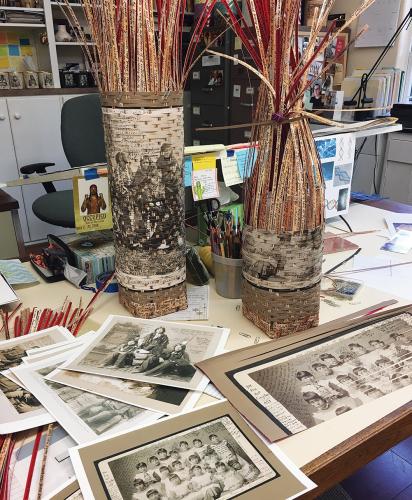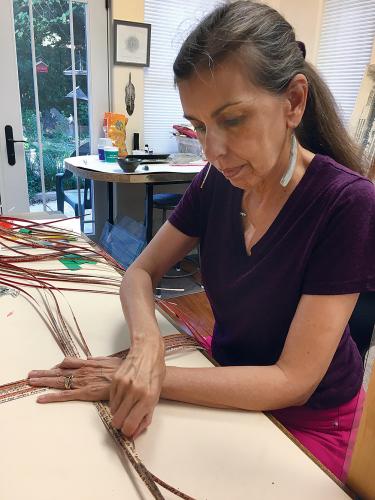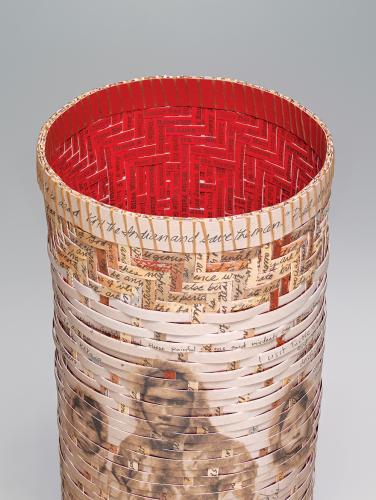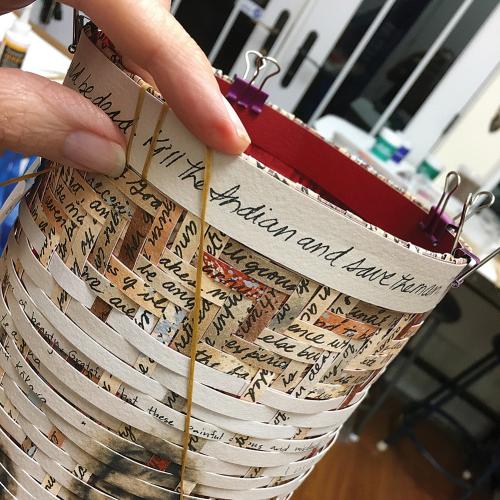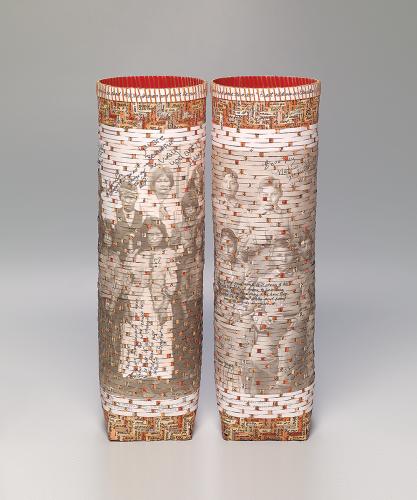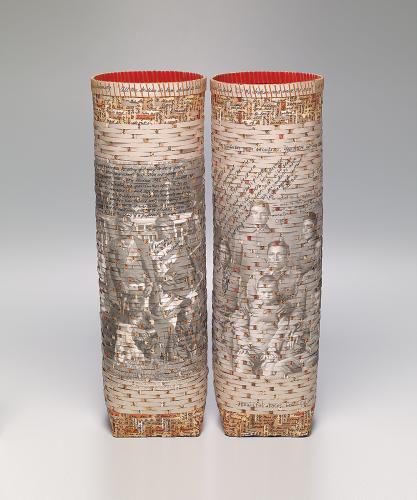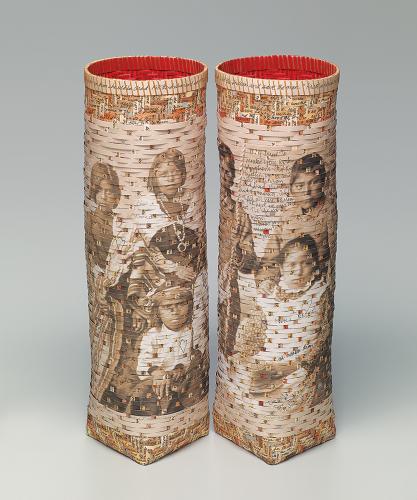Some of the last creative efforts of Eastern Band of Cherokee artist Shan Goshorn now rest in the National Museum of the American Indian. This past spring, NMAI acquired “Resisting the Mission; Filling the Silence,” a set of baskets commemorating a tragic era in American history. Beginning in the 19th century, American Indian children were removed from their homes and forced to attend boarding schools. Once there, they were stripped of their Native identities. Woven during the last two years of her life, the impressive set of seven pairs of baskets is perhaps the magnum opus of Goshorn’s unique works. She used traditional Cherokee weaving techniques to create art with an unexpected purpose—to show the strengths and struggles of American Indian people.
Although Goshorn was most recently recognized for her provocative and expertly woven baskets, she had many talents. During an interview with “Invisible Nations” television series, she says, “I don’t consider myself a photographer, painter or basket maker. I consider myself an artist who chooses the medium that best expresses a statement.”
A member of the Eastern Band of Cherokee Indians, Goshorn worked at her tribe’s Qualla Arts and Crafts Cooperative in Cherokee, North Carolina, as a teenager. There, she photographed Cherokee basket makers as they gathered and prepared materials such as white oak, river cane and honeysuckle. Later, as a young art school graduate, she was commissioned by the Indian Arts and Crafts Board to document in pen-and-ink drawings a number of traditional Cherokee basketry designs. Through studying and drawing the designs, she gained an understanding of their geometry and rhythms and, decades later, she taught herself to weave.
In the 1980s and 1990s, she earned recognition for hand-tinted photographs in which she overlaid portraits of American Indians in traditional regalia with images of the forests, mountains and fields of their homelands. She went on to work in other media, including paint, metals and glass. However, not until 2008 did she begin drawing upon her knowledge of Cherokee basket weaving.
Goshorn concluded that a basket’s familiar form, intricate patterns and intriguing imagery would be a perfect artform to draw viewers in and open them up to think about difficult subjects. So in place of traditional plant materials, Goshorn wove together strips of archival watercolor paper printed with text or with reproductions of historical photographs, maps, treaties or other documents. She used these materials to address topics such as violence against Native women, repatriation of human remains and sacred objects, loss of Indigenous lands as well as the traumatic impacts of American Indian boarding schools.
In 1879, Captain Richard Henry Pratt established the Carlisle Indian Industrial School, a military-style boarding school in Carlisle, Pennsylvania. He separated American Indian children from their homes, families and communities and brought them to the school with the goal of assimilating them into mainstream society. When children arrived at the school, their hair was cut short and their Native clothing was replaced with military-style uniforms. Pratt commissioned photographer John N. Choate to document the children’s physical transformation and what he considered Carlisle’s success in its mission to “civilize” them. The “before and after” photographs dramatically show the result. In a further effort to strip the children of their culture and their Native identity, school authorities and teachers forbade them to speak their tribal languages or practice their cultural traditions and harshly punished them for doing so. Carlisle, and the many Indian boarding schools modeled after it in the late 19th to mid-20th centuries, devastated individuals and families and contributed to a multigenerational loss of language and culture.
When Goshorn was awarded a prestigious Smithsonian Artist Research Fellowship in 2013, she was enabled to study the designs and techniques of Cherokee baskets in Smithsonian collections as well as the archival materials at NMAI’s Cultural Resources Center, the National Anthropological Archives and the National Archives. During her research, she was deeply moved by the photographs of Native children at Carlisle and other boarding schools operated by U.S. government and church authorities. The experience was more personal because several of her own relatives had attended Carlisle. Following her fellowship, Goshorn continued her research in the photographs, student rosters and other documentation of the Carlisle school’s archives in the Cumberland County Historical Society.
For “Resisting the Mission,” Goshorn selected seven pairs of photographs taken of Native children just after their arrival at Carlisle and again a few months later. Goshorn reproduced the photographs on archival watercolor paper and sent or carried them to Native communities, asking people to inscribe them with personal messages to the children. The photographs were then cut into splints, or strips, with which to weave the baskets. On other splints and the baskets’ rims are written words from Pratt’s infamous 1892 speech, during which he argued for killing the Indian in a child in order to “save the man in him.” Inside each basket, printed on a deep red background and held protectively within, are the names of some of the 8,000 children who attended the school before it closed its doors on September 1, 1918.
Perhaps most painful of the enduring traumas inflicted by the Carlisle Indian school is that nearly 200 children died there and were buried in a cemetery on its grounds. In an act of remembrance and mourning, Goshorn collected donated cedar, sage, sweetgrass and tobacco along with handwritten notes to the children, which she and her daughter prepared in bundles that they laid on each of the children’s graves. Today, some of the children’s remains are being repatriated to their communities and families, returning home at last.
In September 2018, The Trout Gallery, the art museum at Dickinson College in Carlisle, marked the centennial of the Carlisle school’s closing with an exhibition of works addressing its lasting impacts. The exhibition featured 37 of Goshorn’s baskets, with the “Resisting the Mission; Filling the Silence” set as its centerpiece. As each basket towers 21 inches in height, together their collective presence dominated the room, says Trout Gallery Director Phillip Earenfight, “They draw you in from a distance. And as you get closer and you are inches away from the baskets, as you read the text and you see the photographs, and you see the ‘before and the after,’ each wave [of emotion] comes crashing over you, one after another, and it doesn’t stop. Few works have that kind of power.”
Goshorn spent more than two years making the baskets, and she labored to finish the collection in time for the exhibition’s opening. She was able to attend but died only weeks later on December 1, 2018, in Tulsa, Oklahoma. She was 61.
“Shan Goshorn was an accomplished artist who used Cherokee basket techniques to create powerful statements about cultural memory and social justice,” says David Penney, NMAI’s associate director for research and scholarship. “She completed the Carlisle school series just before the end of her life. We see it as a culminating statement of her long, productive and highly celebrated career.”
During the last decade of her life, Goshorn created hundreds of baskets, mastering numerous forms and designs. These and her other artworks continue to provoke thought and admiration. A selection of her pieces, sketches and notes will be exhibited beginning in June 2020 at the Gilcrease Museum in Tulsa. The exhibition will include her last piece, “Squaw,” a woven torso of a woman, and remarks in her own words as well as works from other artists who were her close colleagues. Rose McCracken, who manages Shan Goshorn’s studio, says of the exhibition, “We want to honor who Shan was an artist and also who she was as a mentor and friend to so many in the community.”
Goshorn had a gentle but firm hand when it came to the vision and direction of her art, says Earenfight. “She was clear about what was important to her.” She hoped that “Resisting the Mission; Filling the Silence” would contribute to the education and dialogue necessary to bring about desperately needed healing for those affected by Indian boarding schools. She also wished that the set would remain intact and would find a home where it would be well cared for and seen by many.
That the baskets—a culmination of the research she began at Smithsonian’s archives— now reside at NMAI is fitting. Goshorn transformed historical documents and photographs, which often carry stories of pain and cruelty, into vessels of knowledge, understanding, hope and healing. Her powerful baskets confront painful histories and injustices, while honoring the strength, resilience and perseverance of Native people and cultures.


